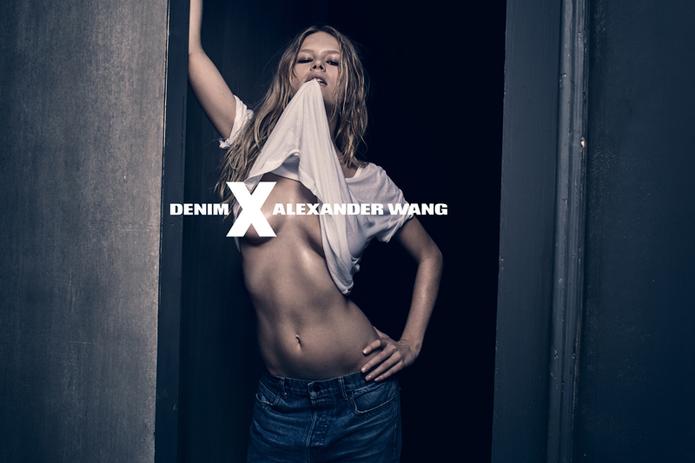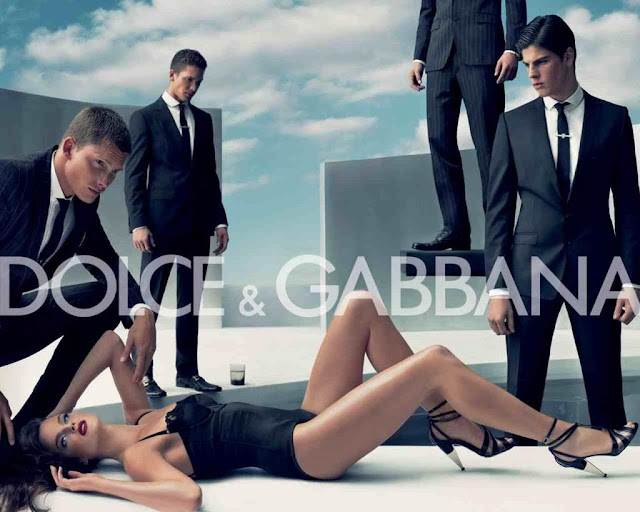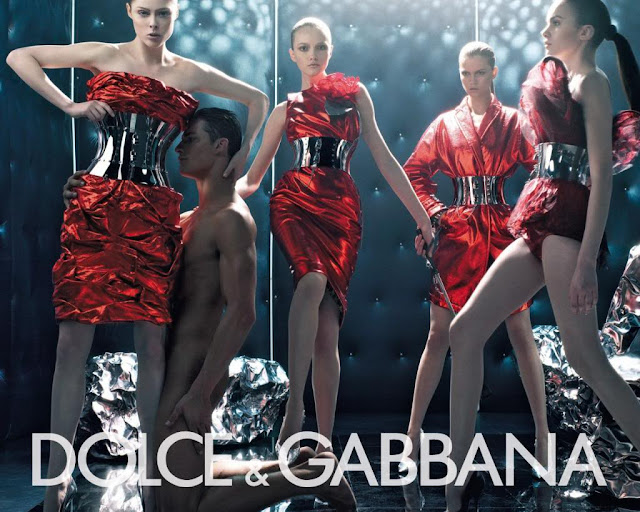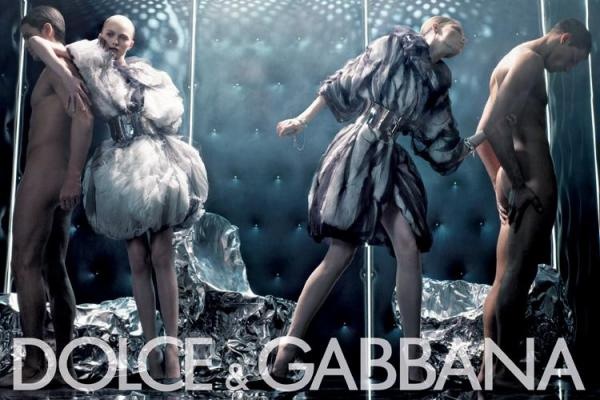Fashion advertising is used by brands to promote their products which they want to increase sales on or launch new products (Easey, 2009). Fashion advertising is a lot slower than other selling areas such as food advertising, (Easey, 2009) as people will shop to be fashionable if they have exposable income, were food is a vital part of staying alive (Maslow, 2004). When fashion advertising is at it's peak, it is during end of season sales or festive periods (Easey, 2009). Consumers in the fashion industry want the new and not old (Easey, 2009), consumers want to be current within the general public eye (Easey, 2009). However consumers money is what determines what they can buy and what quantity they buy it in. Fashion Advertisers will use advertising campaigns to sell their products to the target market who can potentially buy these products, prime focus of many fashion advertising campaigns is sex (Easey, 2009; TomFord, 2014).
The following images are from Diesel Spring-Wear campaign of 2010, a simple message of sex sells but unlucky for Diesel they are selling jeans in this campaign, hence they cannot just simply show people having sex to promote their products. Diesel are using the technique of sex sells in their campaign but using it in a negative way to promote their jeans.

Credit: Diesel Offical

Credit: Diesel Offical

Credit: Diesel Offical
Consumer behaviour plays a massive part in who will be interested by sexual content in fashion advertising campaigns. Depending on what people life/ moral values are, this will depend whether or not this kind of material will interest them in order to buy the fashion item being promoted. Sexualisation in fashion products has almost become the norm for many of fashion brands like Calvin Klein, Diesel or Tom Ford (psychologyformarketers, 2014). The relationship between sex and marketing has been imbedded as a key aspect of selling a product, simply because it works and generates interest (psychologyformarketers, 2014). The answer is sex does sell (psychologyformarketers, 2014). There is apparently no limit to what consumers consider too much or push would we would call acceptable to view, hence this is what Diesel marketing department in 1999 seem to think by the following video.
The following video is an advertisement from Diesel (1999), taking porn film clips and replacing them with funny animations instead of seeing the pornographic scene. Diesel are pushing what consumers want to see and displaying to the public porn as a brand message from Diesel. Distributing scenes to use for a fashion advertising campaign or is this simply showing sex does sell.
Sex used in fashion advertising works so well as it results back to our basic desires and needs from life (Easey, 2009). This desire reverts back to the primeval, stone-age way of thinking, as human beings we only fight for three survival instincts:
-Food
-Danger
-Sex
This is why sex is fashion advertising works so well as humans we have a need for sex in our life. This part of the brain that deals with emotions and what you need to do to survive, find food, fight danger and who to have sex with, relates to our spending habits. This is why fashion advertising and sex work prefect together in the terms of sex will be appealing to people, reverting back to the primal instincts (Easey, 2009). Sexual advertising evokes an emotion from everyone, and when you see a sexual advertising campaign, the primeval part of the brain gets activated and interest is spiked for human, having the need to have sex.(psychologyformarketers, 2014).
Sexual advertisements will always play a huge part in fashion advertising, from the point of the consumers, consumers want to be sexy and to be seen as sexy from the clothes they wear to attract sexual mates. This relates back to our primeval way of life, the need for wanting to have sex, marketers or fashion brands will use this basic concept to sell their products, as hence sex does sell (Easey, 2009).
References
Easey, M., 2009. Fashion Marketing 3rd Edition. Wiley-Blackwell.
Maslow, R., 2004. The Third Force: The Psychology of Abraham Maslow. Maurine Bassett.
Psychology for Marketers, 2014., Psychology for Marketers articles. [online]. [viewed on: 15th November 2016]. Available from: http://psychologyformarketers.com/sex-and-marketing/
Inspiration Feed, 2016., Inspiration feed Sex-Sells. [online]. [viewed 22nd November 2016]. Available from: http://inspirationfeed.com/inspiration/sex-sells-50-creative-sexual-advertisements/
The following images are from Diesel Spring-Wear campaign of 2010, a simple message of sex sells but unlucky for Diesel they are selling jeans in this campaign, hence they cannot just simply show people having sex to promote their products. Diesel are using the technique of sex sells in their campaign but using it in a negative way to promote their jeans.

Credit: Diesel Offical

Credit: Diesel Offical

Credit: Diesel Offical
Consumer behaviour plays a massive part in who will be interested by sexual content in fashion advertising campaigns. Depending on what people life/ moral values are, this will depend whether or not this kind of material will interest them in order to buy the fashion item being promoted. Sexualisation in fashion products has almost become the norm for many of fashion brands like Calvin Klein, Diesel or Tom Ford (psychologyformarketers, 2014). The relationship between sex and marketing has been imbedded as a key aspect of selling a product, simply because it works and generates interest (psychologyformarketers, 2014). The answer is sex does sell (psychologyformarketers, 2014). There is apparently no limit to what consumers consider too much or push would we would call acceptable to view, hence this is what Diesel marketing department in 1999 seem to think by the following video.
The following video is an advertisement from Diesel (1999), taking porn film clips and replacing them with funny animations instead of seeing the pornographic scene. Diesel are pushing what consumers want to see and displaying to the public porn as a brand message from Diesel. Distributing scenes to use for a fashion advertising campaign or is this simply showing sex does sell.
Sex used in fashion advertising works so well as it results back to our basic desires and needs from life (Easey, 2009). This desire reverts back to the primeval, stone-age way of thinking, as human beings we only fight for three survival instincts:
-Food
-Danger
-Sex
This is why sex is fashion advertising works so well as humans we have a need for sex in our life. This part of the brain that deals with emotions and what you need to do to survive, find food, fight danger and who to have sex with, relates to our spending habits. This is why fashion advertising and sex work prefect together in the terms of sex will be appealing to people, reverting back to the primal instincts (Easey, 2009). Sexual advertising evokes an emotion from everyone, and when you see a sexual advertising campaign, the primeval part of the brain gets activated and interest is spiked for human, having the need to have sex.(psychologyformarketers, 2014).
Sexual advertisements will always play a huge part in fashion advertising, from the point of the consumers, consumers want to be sexy and to be seen as sexy from the clothes they wear to attract sexual mates. This relates back to our primeval way of life, the need for wanting to have sex, marketers or fashion brands will use this basic concept to sell their products, as hence sex does sell (Easey, 2009).
References
Easey, M., 2009. Fashion Marketing 3rd Edition. Wiley-Blackwell.
Maslow, R., 2004. The Third Force: The Psychology of Abraham Maslow. Maurine Bassett.
Psychology for Marketers, 2014., Psychology for Marketers articles. [online]. [viewed on: 15th November 2016]. Available from: http://psychologyformarketers.com/sex-and-marketing/
Inspiration Feed, 2016., Inspiration feed Sex-Sells. [online]. [viewed 22nd November 2016]. Available from: http://inspirationfeed.com/inspiration/sex-sells-50-creative-sexual-advertisements/



















